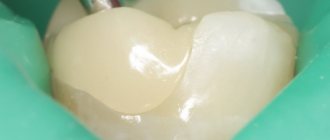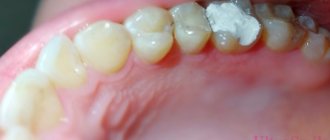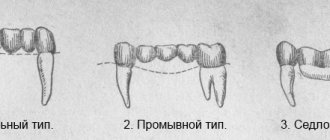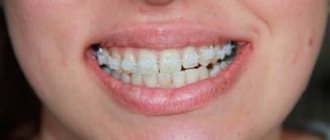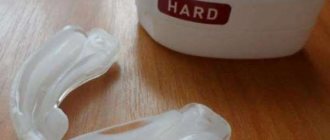- Features of installing a temporary filling
- Why can a temporary filling fall out?
- What to do when a filling falls out
- If the filling falls out on the day of installation
- Loss of filling in sealed and unsealed canals
Temporary fillings are made from composites. Its installation is necessary to seal and protect the tooth cavity during the treatment period. The main task is to prevent the penetration of pathological microorganisms and remnants of food consumed by the patient into the dental canals. Unlike composites, which are fixed after treatment is completed, such a filling can be removed to continue dental procedures. Insufficient fixation can lead to a piece of composite falling out on its own. In order not to provoke complications or damage to the internal cavity of the tooth, you need to know what to do if a temporary filling falls out.
When is a temporary filling required?
A temporary filling is much inferior to a permanent one in terms of strength and durability. It is only needed for a couple of days to keep food and other substances out of the tooth cavity between visits to the dentist. Such a filling can be installed in the following cases:
- — If the root canal treatment was lengthy and the installation of a permanent filling is postponed to the next visit.
- — A temporary filling can serve to hold medication placed in the tooth cavity.
- — If the doctor is not sure that the nerve remains intact. Waiting some time will help you understand whether the tooth can be covered with permanent material.
Why does a tooth need to be restored?
Let's take a quick look at why restoration is necessary anyway. After all, many people only think about how to hide a missing tooth during a conversation, and consider a full-fledged functional restoration to be something optional. So, firstly, a person is faced with a decrease in aesthetics - a “gap” appears in the series. But it is not always noticeable. For example, if there is no chewing tooth (molar), then it is difficult to detect the “hole” from the side, even during a conversation or smile.
Secondly, the edges of the broken crown are sharp, so they injure the gums, lips, cheeks, as well as opposing teeth (antagonists). Thirdly, even if a damaged tooth does not hurt, it is vulnerable to pathogens that are present in the oral cavity. Fourthly, food is chewed worse, and as a result the gastrointestinal tract suffers, the body receives fewer nutrients. Therefore, it is necessary to wear prosthetics.
And most importantly, if a tooth falls out completely or is removed along with the root, then the bone tissue in this area (under the gum) begins to decrease due to atrophic processes, and the level of the gum also decreases. Since there is no root, there is no pressure on the bone, and the body “switches off” this area from nutrition. Subsequently, it becomes difficult to choose a suitable prosthesis and you have to resort to traumatic and not always effective surgery to build up bone tissue.
Damage can be different - the crown can be broken partially or completely, or the tooth can be removed along with the root. Accordingly, prosthetics methods will vary. Which recovery option is best chosen will depend on the clinical situation and the patient's capabilities.
Types of temporary fillings
There are several options for temporary fillings:
- — Water-based artificial dentin. It is a mixture of distilled water and powder (zinc sulfate, zinc oxide, kaolin). The doctor brings the filling material to the desired consistency by adding water.
- — Oil-based dentin. The composition of such artificial dentin is the same, but not with water, but with clove or peach oil. The material does not need to be mixed; it is sold ready-made.
- — Special cement. There are several material options. It is used for teeth exposed to chewing stress. The product also serves as a gasket when filling canals.
- Polymers. The rubber-like paste, which hardens when exposed to light, is a durable material that adheres well to the surface of the tooth.
How can you hide an extracted tooth (if there is no root)
- removable “butterfly prosthesis” (already discussed above),
- fixed classic bridge,
- adhesive bridge,
- prosthetics on implants.
Fixed bridge prosthesis
A classic bridge consists of several crowns connected together. The outer ones are fixed on the supporting teeth, the central one replaces the missing tooth (more precisely, its upper part - a natural crown). Such prosthetics are still very popular because... we can call it familiar to people and most practicing dentists. Although, in fact, it has no obvious advantages. After all, you have to grind and depulp the supporting teeth - this reduces their service life several times.
You need to understand that if you choose a conventional bridge, bone tissue atrophy under the “empty” crown will continue. The prosthesis itself will become uncomfortable over time. Plus, the supporting teeth will be overloaded and gradually collapse. As a result, in a few years the bridge will fall out, you will have to remove its supports and think about new prosthetics.
Adhesive bridge
An adhesive bridge is a temporary orthopedic structure, it is somewhat reminiscent of a traditional bridge, only instead of supporting crowns it has small wings that are glued to adjacent teeth. The aesthetics of the adhesive structure are quite good; the supports for it do not need to be ground (and if necessary, then to a minimum). But the big drawback is poor fixation. Even with moderate pressure, the adhesive “bridge” may fall off. And to glue it, you will need to visit the clinic.
Prosthetics on implants
When using implant prosthetics, the following happens: first, an implant is implanted in place of the missing tooth root. If there are no 2-3 roots, then each will be replaced with an implant. By the way, the implant can be implanted at once, i.e. immediately after tooth extraction - this saves time and money. After some time (from 1 to 6 months), a permanent crown is installed. These months are necessary for the implant to take root in the bone and fuse with it into a single whole. If you immediately put a crown on the implant and start biting or chewing food with it, it will move, and inflammation and rejection may also begin. In the meantime, the implantation takes place, the patient walks with a temporary prosthesis.
Read on the topic: why it is better to choose a crown on an implant - the advantages of the most modern type of prosthetics.
Dentures on implants do not have the main disadvantage of classical dentures - the bone under them does not atrophy. There is also no need to “spoil” neighboring good teeth by grinding, no need to remove “nerves” from them. Therefore, restoration on implants lasts much longer (not 5-7 years, but 10-15 years).
An important nuance - when using prosthetics in the “smile zone”, you can place a ceramic crown only if zirconium dioxide is used between the implant and the prosthesis). And in the chewing department, it is better to give preference to metal ceramics and zirconium dioxide - due to their increased strength.
The only disadvantages of implant prosthetics include the presence of some contraindications. For example, a ban or allergy to anesthesia, or if the bone has severely atrophied. First, it will need to be increased, and then an implant will be placed. And in terms of cost, installing a budget implant with a crown is quite comparable to a prosthetic bridge.
%akc72%
Is it possible to install a temporary filling yourself?
The installation of fillings should only be entrusted to a doctor. The fact is that, for all its rigidity, the tooth is very easily susceptible to infection. If you close a cavity in a tooth without proper preparation, there is a high probability of infection and the development of serious complications. The simplest thing is inflammation of the pulp, or pulpitis. In serious cases, the patient may lose a tooth and even harm neighboring ones if the inflammation spreads.
The desire to fill a tooth with temporary material may arise if a permanent or temporary filling falls out or a piece of the crown part of the tooth breaks off. In these cases, you need to make an appointment with a doctor as soon as possible, and while waiting for the visit, avoid getting food into the resulting cavity and follow simple rules.
Filling of anterior teeth
In the case of front teeth, the aesthetic aspect comes to the fore, so the filling material must have the appropriate properties. Although the front teeth receive better hygiene due to their accessibility, they are also susceptible to caries. Installing a filling on the front teeth is considered a more complex procedure: it is necessary not only to give the filling the desired shape, but also to choose the right color. In most cases, filling of anterior teeth is carried out using compomers, as well as light composite fillings, which harden under the influence of ultraviolet radiation. Be that as it may, in case of serious damage, it is impossible to achieve good aesthetics with the help of filling, so you often have to turn to orthopedic solutions.
What to do if there is a hole in your tooth?
Some manipulations will help you wait for a visit to the doctor without complications:
- First of all, it is important to prevent the accumulation of food debris and plaque inside the tooth. The danger is that bacteria developing in dental plaque release acids that are destructive to teeth.
- If your tooth hurts, you can take a painkiller.
- It would be a good idea to rinse with a warm soda solution.
- It is better to limit chewing on the painful side so as not to provoke an attack of pain.
- There is no need to cover the cavity with cotton wool, plasticine and other improvised means. This can cause complications and the development of infection.
Expert opinion
Lyubov Ivanovna Kopylova
dentist-therapist
Experience: more than 10 years
Temporary filling at home is an option for those who cannot get to the doctor for quality caries treatment. This is not an alternative method of dental treatment and is not an option for those who want to save money on visiting a doctor. Caries can be cured only in a dental clinic, using modern equipment for removing pathological tissue and high-quality filling material. It is important to understand that the temporary filling that you put on yourself does not stop the destructive process!
Types of dental fillings
Classic filling of carious teeth involves the installation of a dental filling without depulpation of the root canals. This technique is used for minor mechanical and carious damage to the tooth (superficial and medium caries) and is carried out in several stages.
When the dental pulp is damaged, in most cases it is necessary to fill the root canals of the teeth. In the case of milk and young molars, there are methods for preserving the functionality of the root - a biological method of treatment using calcium-containing preparations (tooth filling with calcium) or partial amputation of the pulp. This allows you to maintain the blood supply to the tooth and its vitality, which is especially important when it is in the development stage.
Depulpation involves removing the tooth root, cleaning and developing the canals with special instruments and filling them with artificial materials in order to eliminate the risk of developing inflammatory processes. There are various methods of root canal treatment. There is no absolutely ideal method, so the doctor focuses on a specific clinical case.
Prevention of caries
The easiest way to avoid fillings or minimize the number of fillings is to visit your dentist regularly. This should be done at least once every six months. Simple tips will also help keep your teeth healthy:
- Careful hygiene. You need to brush your teeth with a high-quality brush and toothpaste at least twice a day.
- Using dental floss will help remove plaque from hard-to-reach places.
- Rinsing with special liquids will also help keep your gums healthy, which play a huge role in keeping your mouth healthy.
- A balanced diet will help ensure you have enough vitamins and minerals to keep your teeth strong.
Now we treat teeth even better!
Treatment, re-treatment of canals, elimination of caries under a microscope without damaging healthy tooth tissue.
We do everything to save your own tooth. Consultation with specialists is FREE!
More details
Installing a seal on a pin
More recently, it has become common practice in dentistry to install a filling on a post if the tooth is more than 50% destroyed. Thus, the technique made it possible to avoid prosthetics. Filling a tooth with a pin must be preceded by removal of the nerve. Then a special screw is inserted into the root canal and fixed with cement. The procedure is completed by layer-by-layer application of light-polymer composite materials. However, installing a pin does not guarantee reliability and safety. Over time, the cement breaks down, causing microbes to get under the filling, causing the formation of caries. Having chosen modern dentistry to install a filling, you are unlikely to encounter such technology.


